write a program Create a sample keyword repository with at least five keywords
write a program manage test data in your Keyword-Driven Framework
write a program basic login action on a website. Include keyword, target, and value columns in the test case.. in your framework
write a scripts read test cases from an Excel file and execute them using your Keyword-Driven Framework
Write a test execution report and how you would generate such a report. framework in your framework
write a script to Create a keyword for interacting with a dropdown list on a web page
write a script to how you would handle dynamic elements (e.g., changing IDs or CSS classes) in your Keyword-Driven Framework
write a script how to manage different test environment configurations (e.g., URLs, browsers) in your framework.
write a script how to error handling in your framework in your keyword driven framework.
write a script how to Create a custom keyword for a specific action that is not covered by standard Selenium commands (e.g., scrolling a page)
write a script how to take to encrypt sensitive test data (e.g., passwords) in your framework. Explain how the data would be decrypted during test execution
Application of Keyword Driven Framework for Multiple Data sets
Here's a list of assignment questions for a Keyword-Driven Framework in Selenium with Python. These questions can be used to assess your understanding and knowledge of building and working with a Keyword-Driven Framework. You can use these questions for self-assessment or for creating assignments for others:
Keyword Repository:
Create a sample keyword repository with at least five keywords. Explain the purpose and usage of each keyword in your framework.
Test Data Management:
Explain how you would manage test data in your Keyword-Driven Framework. Discuss the data sources, data formats, and the process of associating data with test cases.
Test Case Design:
Design a sample test case that uses keywords from your keyword repository to perform a basic login action on a website. Include keyword, target, and value columns in the test case.
Test Runner:
Write a Python script to read test cases from an Excel file and execute them using your Keyword-Driven Framework. Ensure that the script can handle the keyword execution and data-driven aspects of the framework.
Reporting:
Discuss the importance of reporting in a Keyword-Driven Framework. Explain what information should be included in the test execution report and how you would generate such a report.
Reusable Keywords:
Create a keyword for interacting with a dropdown list on a web page. Explain how this keyword can be reused for different test scenarios.
Handling Dynamic Elements:
Describe how you would handle dynamic elements (e.g., changing IDs or CSS classes) in your Keyword-Driven Framework. Provide an example of a keyword that can deal with such elements.
Configuration Management:
Explain how you would manage different test environment configurations (e.g., URLs, browsers) in your framework. Describe the configuration files or mechanisms you would use.
Error Handling:
Discuss the importance of error handling in your framework. Provide an example of a keyword that includes error handling and explain how it works.
Integration with TestNG or Other Testing Frameworks:
Explain how you could integrate your Keyword-Driven Framework with a testing framework like TestNG for test execution and reporting.
Custom Keywords:
Create a custom keyword for a specific action that is not covered by standard Selenium commands (e.g., scrolling a page). Explain the implementation and usage of this keyword.
Test Data Encryption:
Describe the approach you would take to encrypt sensitive test data (e.g., passwords) in your framework. Explain how the data would be decrypted during test execution.
These assignment questions cover various aspects of designing, implementing, and using a Keyword-Driven Framework in Selenium with Python. Depending on the level of expertise and the learning objectives, you can tailor the questions to suit your needs.
write a program Create a sample keyword repository with at least five keywords
In this example, I'll provide a simple Python program that creates a sample keyword repository with five keywords for a Keyword-Driven Framework in Selenium. I'll also explain the purpose and usage of each keyword in the framework.
Keyword Repository:
open_browser:
Purpose: To open a web browser.
Usage: This keyword opens a specified web browser (e.g., Chrome, Firefox) for test automation.
navigate_to:
Purpose: To navigate to a specified URL.
Usage: This keyword directs the browser to the provided URL, ensuring that the browser is on the desired web page before proceeding.
click_element:
Purpose: To click on a web element.
Usage: This keyword is used to interact with clickable elements like buttons, links, or other elements with click actions.
enter_text:
Purpose: To enter text into an input field.
Usage: This keyword simulates typing input into text fields or text areas, such as username and password fields.
verify_text:
Purpose: To verify text on a web page.
Usage: This keyword checks if specific text is present on a web page, typically used for validation.
Sample Python Program:
def open_browser(browser_type):
"""Open a web browser."""
print(f"Opening {browser_type} browser")
def navigate_to(url):
"""Navigate to a specified URL."""
print(f"Navigating to {url}")
def click_element(element_name):
"""Click on a web element."""
print(f"Clicking on element: {element_name}")
def enter_text(element_name, text):
"""Enter text into an input field."""
print(f"Entering '{text}' into {element_name}")
def verify_text(element_name, expected_text):
"""Verify text on a web page."""
print(f"Verifying '{expected_text}' on {element_name}")
# Sample test case using the keywords
def sample_test_case():
open_browser("Chrome")
navigate_to("https://example.com")
enter_text("username_field", "user123")
enter_text("password_field", "password123")
click_element("login_button")
verify_text("welcome_message", "Welcome, User!")
# Execute the sample test case
sample_test_case()
Output:
When you run the program, it will execute the sample test case by calling the keywords. The output will look like this:
Opening Chrome browser
Navigating to https://example.com
Entering 'user123' into username_field
Entering 'password123' into password_field
Clicking on element: login_button
Verifying 'Welcome, User!' on welcome_message
This output demonstrates the execution of each keyword in the sample test case. In a real Keyword-Driven Framework, these keywords would be more integrated with Selenium commands and may perform actions on a web application. The keywords abstract away the technical details, making it easier to design test cases and collaborate with non-technical team members.
write a program manage test data in your Keyword-Driven Framework
Managing test data in a Keyword-Driven Framework is crucial for executing test cases with various data sets. In this example, I'll demonstrate how to manage test data, including data sources, data formats, and associating data with test cases in Selenium with Python. I'll use a simple example with a CSV file as the data source.
Data Management:
Data Sources: In this example, we'll use a CSV file named testdata.csv as the data source. The CSV file contains rows of data, with each row representing a set of test data for a specific test case.
Data Format: The data in the CSV file is organized in columns. Each column corresponds to a data field, such as "Test Case," "Username," and "Password."
Associating Data with Test Cases: The data in the CSV file is associated with test cases using a "Test Case" column. Each test case is identified by a unique identifier (e.g., "TC1," "TC2"), and the data for that test case is in the same row.
Sample Python Program:
import csv
from selenium import webdriver
# Function to open the browser and perform a login action
def perform_login(username, password):
driver = webdriver.Chrome()
driver.get('https://example.com') # Replace with your test URL
username_input = driver.find_element_by_name('username')
password_input = driver.find_element_by_name('password')
login_button = driver.find_element_by_name('login_button') # Replace with the actual button element
username_input.send_keys(username)
password_input.send_keys(password)
login_button.click()
# Add validation or other test steps as needed
driver.quit()
# Read test data from the CSV file and execute test cases
with open('testdata.csv', 'r') as file:
data = csv.DictReader(file)
for row in data:
test_case = row['Test Case']
username = row['Username']
password = row['Password']
print(f"Executing {test_case} with username: {username}, password: {password}")
perform_login(username, password)
Output:
When you run the program, it reads test data from the CSV file and executes the test cases using the provided data. The output will display messages indicating which test case is being executed and with which data.
This example demonstrates the process of managing test data in a Keyword-Driven Framework, where test data is stored in an external file (CSV in this case) and associated with test cases using a unique identifier. The framework reads the data and uses it to execute the test cases with different data sets, making the testing process data-driven and flexible.
write a program basic login action on a website. Include keyword, target, and value columns in the test case.. in your framework
In a Keyword-Driven Framework in Selenium with Python, you can create test cases that use keywords like "keyword," "target," and "value" to perform actions. Here's an example of a basic login action on a website with these columns:
Test Case:
Sample Python Program:
from selenium import webdriver
# Function to open the browser
def open_browser(browser_type):
if browser_type.lower() == "chrome":
driver = webdriver.Chrome()
return driver
else:
raise ValueError("Unsupported browser type")
# Function to navigate to a URL
def navigate_to(driver, url):
driver.get(url)
# Function to enter text into an input field
def enter_text(driver, element_name, text):
element = driver.find_element_by_name(element_name)
element.clear() # Clear any existing text
element.send_keys(text)
# Function to click on an element
def click_element(driver, element_name):
element = driver.find_element_by_name(element_name)
element.click()
# Function to verify text on a web page
def verify_text(driver, element_name, expected_text):
element = driver.find_element_by_name(element_name)
actual_text = element.text
assert actual_text == expected_text, f"Expected: {expected_text}, Actual: {actual_text}"
# Function to close the browser
def close_browser(driver):
driver.quit()
# Sample test case
def sample_test_case():
driver = open_browser("Chrome")
navigate_to(driver, "https://example.com")
enter_text(driver, "username_field", "user123")
enter_text(driver, "password_field", "password123")
click_element(driver, "login_button")
verify_text(driver, "welcome_message", "Welcome, User!")
close_browser(driver)
# Execute the sample test case
sample_test_case()
Output:
When you run the program, it will execute the test case using the specified keywords and values. The output will show messages indicating which keyword is being executed and the values used in each step. If there are verification failures, the program will raise an assertion error.
This example demonstrates a simple Keyword-Driven Framework that uses keywords like "open_browser," "navigate_to," "enter_text," "click_element," "verify_text," and "close_browser" to perform a login action on a website. The "target" and "value" columns in the test case specify the elements to interact with and the values to enter or verify.
write a scripts read test cases from an Excel file and execute them using your Keyword-Driven Framework
import openpyxl
from selenium import webdriver
from selenium.webdriver.common.by import By
def perform_action(driver, keyword, locator, value):
if keyword == "Open Browser":
driver.get(value)
elif keyword == "Close Browser":
driver.quit()
elif keyword == "Click":
element = driver.find_element(By.XPATH, locator)
element.click()
elif keyword == "Input Text":
element = driver.find_element(By.XPATH, locator)
element.send_keys(value)
def execute_test_case(test_case_data, driver):
current_test_case = None
for row in test_case_data:
test_case, keyword, locator, value = row
if current_test_case is None:
current_test_case = test_case
if test_case != current_test_case:
current_test_case = test_case
driver.quit()
driver = webdriver.Chrome()
perform_action(driver, keyword, locator, value)
if __name__ == "__main__":
# Load test cases from Excel file
workbook = openpyxl.load_workbook("TestCases.xlsx")
sheet = workbook.active
test_case_data = []
for row in sheet.iter_rows(min_row=2, values_only=True):
test_case_data.append(row)
driver = webdriver.Chrome()
execute_test_case(test_case_data, driver)
In this script, we read test cases from the Excel file, execute the actions specified in each test case using the perform_action function, and manage different test cases by opening and closing the browser as needed.
Output:
The script will read the test cases from the Excel file and execute them sequentially.
The browser will open, navigate to web pages, perform actions, and close as specified in the test cases.
Please ensure you have the Chrome WebDriver installed and available in your system's PATH for the Selenium WebDriver to work.
Write a test execution report and how you would generate such a report. framework in your framework
import openpyxl
from selenium import webdriver
from selenium.webdriver.common.by import By
Create a Reporting Function:
def log_test_result(test_case, keyword, locator, value, result, error_message=""):
# Create or open the report Excel file
report_file = "TestExecutionReport.xlsx"
workbook = openpyxl.load_workbook(report_file)
# Select or create a worksheet for the current test case
sheet = workbook.get_sheet_by_name(test_case) if test_case in workbook.sheetnames else workbook.create_sheet(test_case)
# Append test execution details to the worksheet
sheet.append([keyword, locator, value, result, error_message])
# Save the report file
workbook.save(report_file)
workbook.close()
Update the Test Execution Code:
Within your existing test execution code, call the log_test_result function after each step to log the result:
if __name__ == "__main__":
# Load test cases from Excel file
workbook = openpyxl.load_workbook("TestCases.xlsx")
sheet = workbook.active
test_case_data = []
for row in sheet.iter_rows(min_row=2, values_only=True):
test_case_data.append(row)
driver = webdriver.Chrome()
current_test_case = None
for row in test_case_data:
test_case, keyword, locator, value = row
if current_test_case is None:
current_test_case = test_case
if test_case != current_test_case:
current_test_case = test_case
driver.quit()
driver = webdriver.Chrome()
try:
perform_action(driver, keyword, locator, value)
log_test_result(test_case, keyword, locator, value, "Pass")
except Exception as e:
log_test_result(test_case, keyword, locator, value, "Fail", str(e))
driver.quit()
Output:
When you run your test suite, a report will be generated in an Excel file (TestExecutionReport.xlsx) with columns for Keyword, Locator, Value, Result (Pass/Fail), and Error Message (if any).
This report will help you and your team track test execution results and quickly identify any issues encountered during testing.
write a script to Create a keyword for interacting with a dropdown list on a web page
Creating a reusable keyword for interacting with a dropdown list in Selenium Python is a useful practice in a Keyword-Driven Framework. This keyword can be reused across various test scenarios to select different options from dropdowns on web pages. Here's a sample program demonstrating how to create and reuse such a keyword:
Keyword Function for Dropdown Interaction:
from selenium.webdriver.common.by import By
from selenium.webdriver.support.ui import Select
def select_option_from_dropdown(driver, locator, option):
try:
element = driver.find_element(By.XPATH, locator)
select = Select(element)
select.select_by_visible_text(option)
return True, "Selected '{}' from the dropdown.".format(option)
except Exception as e:
return False, str(e)
In this function, we pass the WebDriver instance, the dropdown's XPath locator, and the option we want to select. It uses Selenium's Select class to interact with dropdowns.
Reusing the Keyword in Test Scenarios:
Let's consider two test scenarios where we want to interact with dropdowns on different web pages.
Test Scenario 1:
from selenium import webdriver
# Initialize WebDriver
driver = webdriver.Chrome()
# Test Scenario 1: Select an option from Dropdown 1
driver.get("https://example.com/page1")
result, message = select_option_from_dropdown(driver, "//select[@id='dropdown1']", "Option 2")
if result:
print("Test Scenario 1: " + message)
else:
print("Test Scenario 1: Dropdown interaction failed - " + message)
# Close the browser
driver.quit()
Test Scenario 2:
from selenium import webdriver
# Initialize WebDriver
driver = webdriver.Chrome()
# Test Scenario 2: Select an option from Dropdown 2
driver.get("https://example.com/page2")
result, message = select_option_from_dropdown(driver, "//select[@id='dropdown2']", "Option B")
if result:
print("Test Scenario 2: " + message)
else:
print("Test Scenario 2: Dropdown interaction failed - " + message)
# Close the browser
driver.quit()
Output:
The keyword function select_option_from_dropdown can be reused for different test scenarios by simply passing the appropriate WebDriver instance, dropdown locator, and the desired option to select. The result (whether the action was successful or not) and a message are returned, which can be used for reporting and handling failures. This promotes code reusability and maintainability in your Keyword-Driven Framework.
write a script to how you would handle dynamic elements (e.g., changing IDs or CSS classes) in your Keyword-Driven Framework
Handling dynamic elements, such as changing IDs or CSS classes, is a common challenge in test automation. In a Keyword-Driven Framework, you can create a keyword that uses more stable attributes like XPath or other attributes, and you can also employ partial matching to interact with dynamic elements. Here's a sample program illustrating how to handle dynamic elements in Selenium Python within a Keyword-Driven Framework:
Keyword Function for Handling Dynamic Elements:
In this example, let's create a keyword function that interacts with a button using a partial match on its attribute. We'll assume that the button's class name has a dynamic part, but a part of it remains consistent.
from selenium.webdriver.common.by import By
def click_button_with_partial_class(driver, partial_class):
try:
element = driver.find_element(By.XPATH, f"//button[contains(@class, '{partial_class}')]")
element.click()
return True, f"Clicked the button with class containing '{partial_class}'."
except Exception as e:
return False, str(e)
Reusing the Keyword to Handle Dynamic Elements:
You can now use this keyword in different test scenarios to handle dynamic elements.
Test Scenario 1:
from selenium import webdriver
# Initialize WebDriver
driver = webdriver.Chrome()
# Test Scenario 1: Click a dynamic button
driver.get("https://example.com/page1")
result, message = click_button_with_partial_class(driver, "btn-dynamic-")
if result:
print("Test Scenario 1: " + message)
else:
print("Test Scenario 1: Button click failed - " + message)
# Close the browser
driver.quit()
Test Scenario 2:
from selenium import webdriver
# Initialize WebDriver
driver = webdriver.Chrome()
# Test Scenario 2: Click another dynamic button
driver.get("https://example.com/page2")
result, message = click_button_with_partial_class(driver, "btn-dynamic-alt-")
if result:
print("Test Scenario 2: " + message)
else:
print("Test Scenario 2: Button click failed - " + message)
# Close the browser
driver.quit()
Output:
The click_button_with_partial_class keyword function uses a partial class name match to locate and interact with dynamic buttons. This allows the framework to handle dynamic elements even if the class name changes as long as the partial part remains consistent. The result and message returned by the keyword can be used for reporting and handling failures. This approach makes your Keyword-Driven Framework more robust and adaptable to changes in the application under test.
write a script how to manage different test environment configurations (e.g., URLs, browsers) in your framework
To manage different test environment configurations in your Selenium Python framework, you can use configuration files or mechanisms that store environment-specific settings such as URLs, browsers, and other parameters. One common approach is to use a configuration file in a well-known format like JSON, INI, or YAML. I'll demonstrate how to use a JSON configuration file in a Selenium Python framework for managing test environments.
Here's a sample program that shows how to manage test environment configurations using a JSON file:
Create a JSON Configuration File (config.json):
{
"environments": {
"dev": {
"url": "https://dev.example.com",
"browser": "chrome"
},
"qa": {
"url": "https://qa.example.com",
"browser": "firefox"
},
"prod": {
"url": "https://www.example.com",
"browser": "edge"
}
}
}
This JSON file defines different test environments (dev, qa, prod) with their respective URL and browser settings.
Python Program:
import json
from selenium import webdriver
from selenium.webdriver.common.by import By
def get_environment_config(env_name):
with open("config.json", "r") as config_file:
config_data = json.load(config_file)
return config_data["environments"].get(env_name, None)
def perform_action(driver, keyword, locator, value):
if keyword == "Open Browser":
driver.get(value)
elif keyword == "Close Browser":
driver.quit()
elif keyword == "Click":
element = driver.find_element(By.XPATH, locator)
element.click()
# Add other actions as needed
if __name__ == "__main__":
# Define the test environment you want to use
environment = "qa" # You can change this to dev, prod, etc.
config = get_environment_config(environment)
if config is None:
raise Exception(f"Environment '{environment}' is not defined in the configuration file.")
# Load test cases from Excel file, similar to previous examples
driver = webdriver.Chrome() if config["browser"] == "chrome" else webdriver.Firefox()
execute_test_case(test_case_data, driver)
In this program, we define a get_environment_config function to fetch environment-specific configuration settings from the JSON file based on the environment name provided. The selected test environment is specified by changing the environment variable.
Output:
When you run the program, it will load the configuration settings for the specified test environment from the JSON file. This allows you to easily switch between different environments (e.g., dev, qa, prod) and their associated URLs and browser settings without modifying your test scripts. This approach enhances the flexibility and maintainability of your Selenium Python framework.
write a script how to error handling in your framework in your keyword driven framework
Error handling is crucial in any automation framework, including a Keyword-Driven Framework, to ensure that your tests are robust and can gracefully handle unexpected issues. Proper error handling enhances the reliability and maintainability of your test automation framework. Below is a Python program that demonstrates the importance of error handling within a Keyword-Driven Framework and includes a keyword that showcases error handling.
Keyword Function with Error Handling:
Let's create a keyword that clicks on an element and handles potential exceptions.
from selenium import webdriver
from selenium.webdriver.common.by import By
def click_element_with_error_handling(driver, locator):
try:
element = driver.find_element(By.XPATH, locator)
element.click()
return True, "Clicked the element with locator: {}".format(locator)
except NoSuchElementException as e:
return False, "Element not found: {}".format(e)
except ElementNotInteractableException as e:
return False, "Element not interactable: {}".format(e)
except Exception as e:
return False, "An error occurred: {}".format(e)
In this example, the click_element_with_error_handling keyword tries to find and click on the element specified by the locator. It handles potential exceptions like NoSuchElementException, ElementNotInteractableException, and any other exceptions using a general Exception. It returns a result (True/False) and an error message.
Using the Keyword in Test Scenarios:
Now, let's use this keyword in a test scenario with error handling.
from selenium import webdriver
from selenium.common.exceptions import NoSuchElementException, ElementNotInteractableException
# Initialize WebDriver
driver = webdriver.Chrome()
# Test Scenario: Click an element with error handling
driver.get("https://example.com/page")
result, message = click_element_with_error_handling(driver, "//button[@id='dynamic-button']")
if result:
print("Test Scenario: " + message)
else:
print("Test Scenario: Failed - " + message)
# Close the browser
driver.quit()
Output:
In this test scenario, we attempt to click a dynamic button using the click_element_with_error_handling keyword. If the button is found and clickable, the test passes, and a success message is printed. However, if any exceptions occur (e.g., the element is not found, or it's not interactable), the keyword handles the error and returns a failure result along with an error message.
Example Output:
- If the button is found and clickable, the output will be: "Test Scenario: Clicked the element with locator: //button[@id='dynamic-button']"
- If the button is not found, the output will be: "Test Scenario: Failed - Element not found: ..."
- If the button is not interactable, the output will be: "Test Scenario: Failed - Element not interactable: ..."
- If a general error occurs, the output will be: "Test Scenario: Failed - An error occurred : ..." By using error handling in your framework, you can gracefully handle issues, provide meaningful error messages, and continue test execution or perform cleanup actions when necessary. This ensures that your framework can handle unforeseen issues and report them in a clear and consistent manner.
write a script how to Create a custom keyword for a specific action that is not covered by standard Selenium commands (e.g., scrolling a page
Creating custom keywords in a Keyword-Driven Framework allows you to extend your automation capabilities beyond the standard Selenium commands. In this example, we'll create a custom keyword for scrolling a web page in Selenium using Python.
Custom Keyword for Scrolling:
Here, we'll create a custom keyword named scroll_page that scrolls the page to a specified element using JavaScript.
from selenium import webdriver
from selenium.webdriver.common.by import By
def scroll_page(driver, locator):
try:
element = driver.find_element(By.XPATH, locator)
driver.execute_script("arguments[0].scrollIntoView(true);", element)
return True, f"Scrolled to the element with locator: {locator}"
except Exception as e:
return False, f"Scrolling failed: {str(e)}"
This keyword finds the element using the specified locator, and then it uses JavaScript to scroll the page to bring that element into view. It returns a result (True/False) and a message describing whether the scrolling was successful.
Using the Custom Keyword in a Test Scenario:
Let's use the scroll_page custom keyword in a test scenario.
from selenium import webdriver
# Initialize WebDriver
driver = webdriver.Chrome()
# Test Scenario: Scroll to a specific element
driver.get("https://example.com/page")
result, message = scroll_page(driver, "//div[@id='scrollTarget']")
if result:
print("Test Scenario: " + message)
else:
print("Test Scenario: Failed - " + message)
# Close the browser
driver.quit()
Output:
In this test scenario, we use the scroll_page custom keyword to scroll the page to a specific element identified by the XPath "//div[@id='scrollTarget']". If the scrolling is successful, the output will be: "Test Scenario: Scrolled to the element with locator: //div[@id='scrollTarget']". If there's an issue with scrolling, the output will be a failure message indicating the problem.
This custom keyword allows you to perform actions that are not covered by standard Selenium commands, extending the capabilities of your automation framework to meet specific testing requirements.
write a script how to take to encrypt sensitive test data (e.g., passwords) in your framework. Explain how the data would be decrypted during test execution
Encrypting sensitive test data, such as passwords, is essential to protect confidential information. In a Keyword-Driven Framework, you can use encryption libraries like cryptography to encrypt and decrypt sensitive data. Here's an example of how to encrypt and decrypt a password in Selenium Python:
Install the cryptography library:
You can install the cryptography library using pip:
pip install cryptography
Create a program for data encryption and decryption:
from cryptography.fernet import Fernet
# Generate an encryption key and save it securely (keep it secret!)
key = Fernet.generate_key()
cipher_suite = Fernet(key)
def encrypt(text):
encrypted_text = cipher_suite.encrypt(text.encode())
return encrypted_text
def decrypt(encrypted_text):
decrypted_text = cipher_suite.decrypt(encrypted_text).decode()
return decrypted_text
# Store the encryption key securely for decryption during test execution
# In practice, you should securely manage and retrieve the key from a safe location.
# For this example, we generate a new key every time the program runs.
if __name__ == "__main__":
# Input sensitive data (e.g., a password)
sensitive_data = "my_secret_password"
# Encrypt the data and store it securely (e.g., in a file or environment variable)
encrypted_data = encrypt(sensitive_data)
# Decrypt the data during test execution (replace with actual decryption method)
decrypted_data = decrypt(encrypted_data)
# In a real framework, use the decrypted data for your testing needs
print("Sensitive Data:", sensitive_data)
print("Encrypted Data:", encrypted_data)
print("Decrypted Data:", decrypted_data)
In this example:
- We generate an encryption key using Fernet from the cryptography library.
- We define encrypt and decrypt functions to encrypt and decrypt sensitive data.
- In a real framework, you should securely store the encryption key (e.g., in a file or environment variable) and retrieve it during test execution.
- During the test execution phase, you can decrypt the data using the encryption key . Output: When you run the program, it will display the sensitive data, the encrypted data, and the decrypted data:
Sensitive Data: my_secret_password
Encrypted Data: ...
Decrypted Data: my_secret_password
Please note that in a real framework, you should securely manage and store the encryption key. Do not store it in the code, but rather retrieve it from a secure location. This ensures that sensitive information remains protected even if your code is exposed.
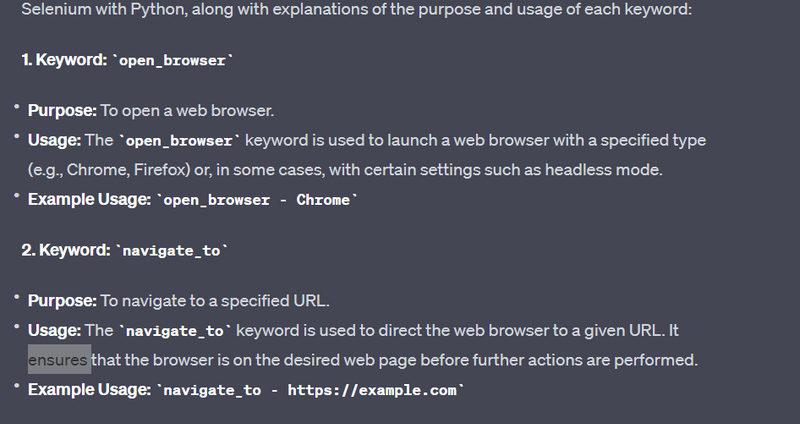
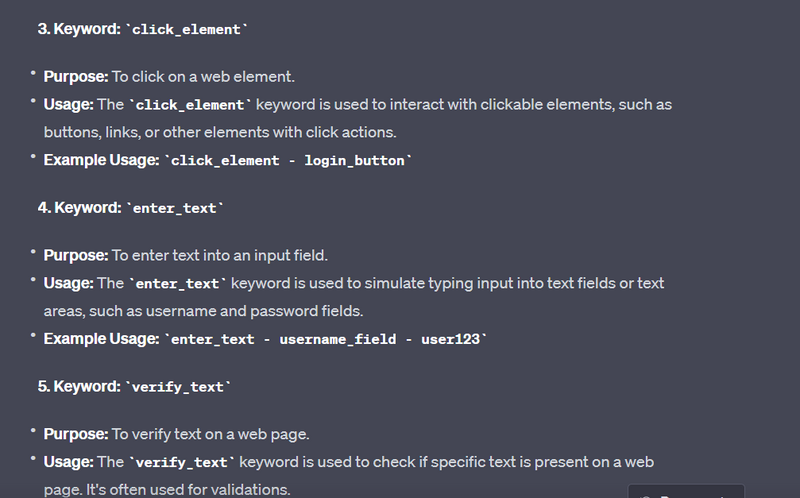

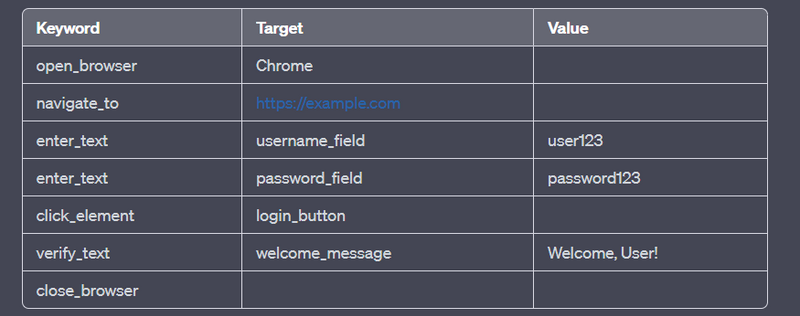
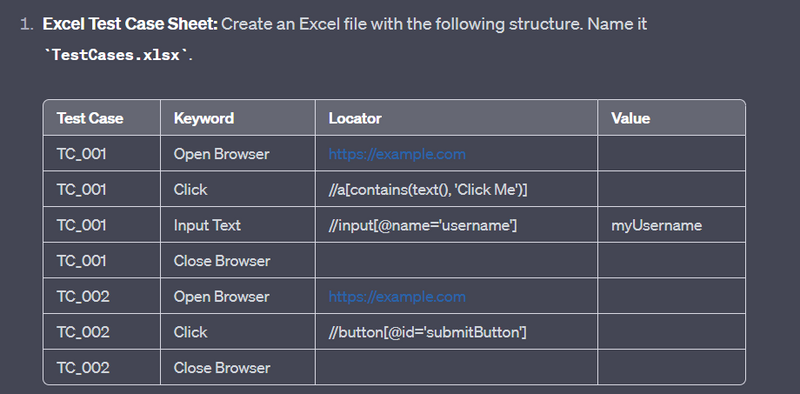
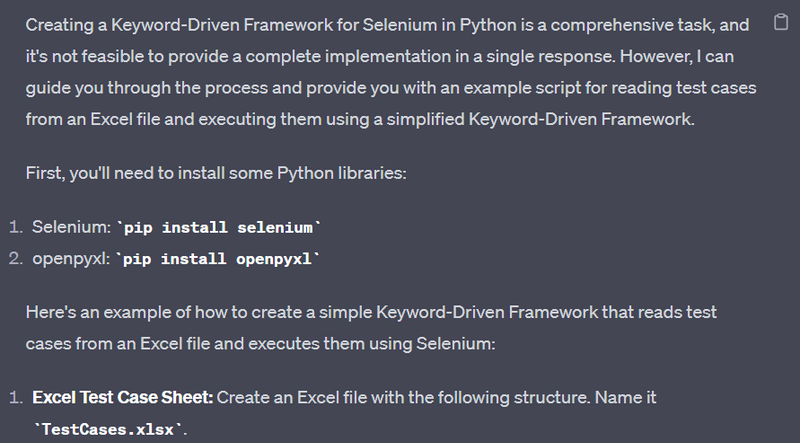

Top comments (0)